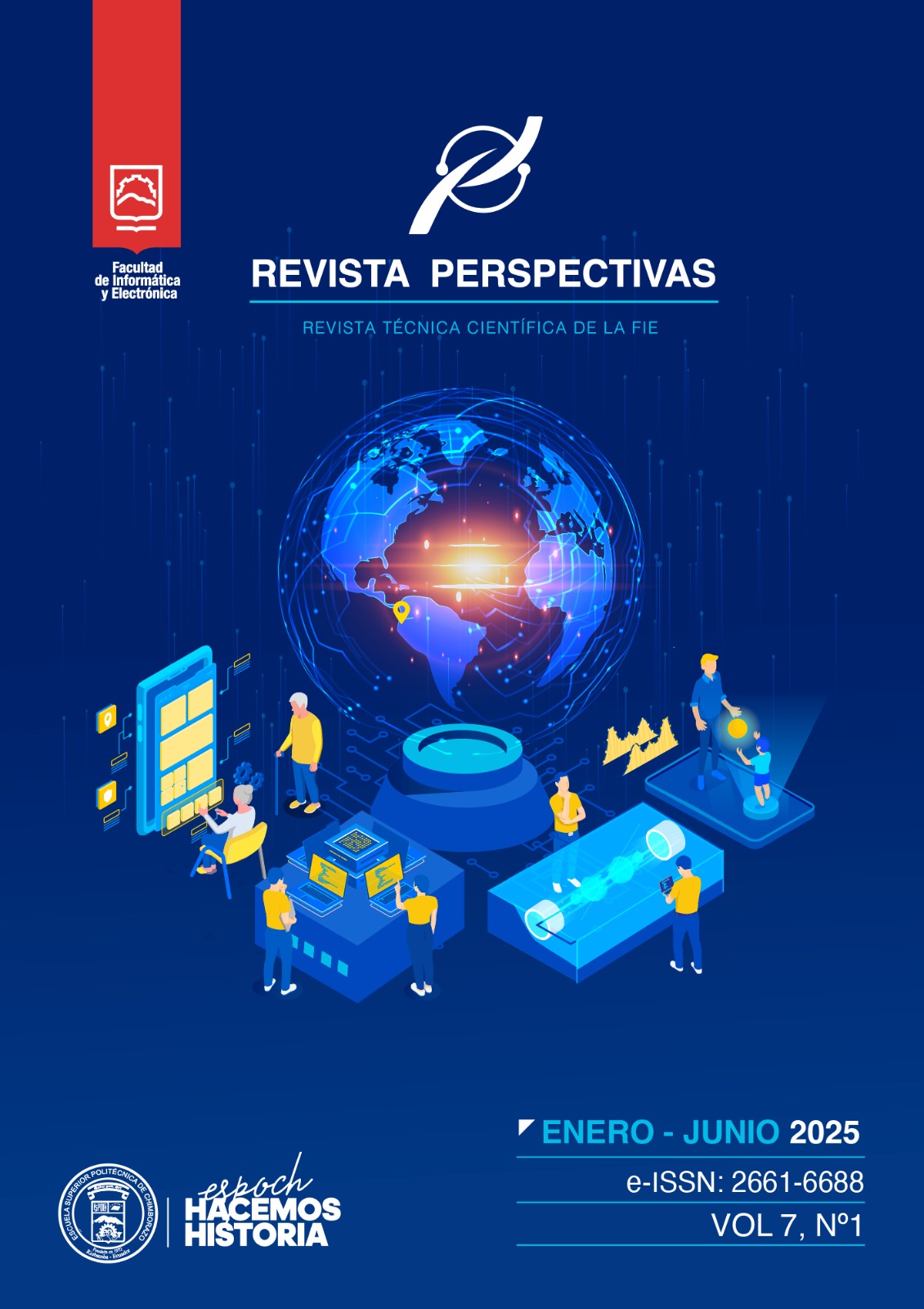Algoritmos de Machine Learning usados en mantenimiento predictivo: un mapeo sistemático de literatura
DOI:
https://doi.org/10.47187/perspectivas.7.1.227Palabras clave:
Machine Learning, Mantenimiento Predictivo, Mapeo Sistemático de Literatura, PdMResumen
El mantenimiento predictivo es una práctica que gracias a tecnologías como la inteligencia artificial e internet de las cosas permiten que las empresas industriales lo puedan aplicar en sus procesos. Los algoritmos de Machine Learning son utilizados en muchos campos y sirven para realizar tareas de predicción o clasificación. El mantenimiento predictivo es un campo de Investigación que aporta con nuevas prácticas, estrategias o metodologías. Al ser un campo relativamente nuevo las metodologías aún se encuentran dispersas y existe poca información sobre la madurez de los algoritmos. Para proporcionar una base sólida, se presenta un mapeo sistemático de literatura con el objetivo de ofrecer a ingenieros e investigadores una visión general de los algoritmos de Machine Learning usados en mantenimiento predictivo. Los resultados obtenidos muestran un crecimiento en los últimos años demostrando un interés en este campo de investigación. Sin embargo, la mayoría de las contribuciones en este campo se pueden resumir como pruebas concepto y aún resulta difícil obtener un prototipo para que sea validado como un sistema completo y certificado. En este artículo se describen los principales algoritmos de Machine Learning usados en mantenimiento predictivo de acuerdo con el tipo de uso y su supervisión, además, se analizan los parámetros de entrada y las salidas de los mismos y por último se determina su nivel de madurez.
Métricas
Citas
P. Das, S. Perera, S. Senaratne, and R. Osei-Kyei, “Paving the way for industry 4.0 maturity of construction enterprises: a state of the art review,” Engineering, Construction and Architectural Management, vol. ahead-of-print, no. ahead-of-print, 2022, doi: 10.1108/ECAM-11-2021-1001/FULL/XML.
T. Borgi, A. Hidri, B. Neef, and M. S. Naceur, “Data analytics for predictive maintenance of industrial robots,” Proceedings of International Conference on Advanced Systems and Electric Technologies, IC_ASET 2017, pp. 412–417, Jul. 2017, doi: 10.1109/ASET.2017.7983729.
R. Alkhazaleh, K. Mykoniatis, and A. Alahmer, “The Success of Technology Transfer in the Industry 4.0 Era: A Systematic Literature Review,” Journal of Open Innovation: Technology, Market, and Complexity 2022, Vol. 8, Page 202, vol. 8, no. 4, p. 202, Nov. 2022, doi: 10.3390/JOITMC8040202.
R. S. Peres, A. Dionisio Rocha, P. Leitao, and J. Barata, “IDARTS – Towards intelligent data analysis and real-time supervision for industry 4.0,” Comput Ind, vol. 101, pp. 138–146, Oct. 2018, doi: 10.1016/J.COMPIND.2018.07.004.
D. Martin, S. Heinzel, J. K. von Bischhoffshausen, and N. Kühl, “Deep Learning Strategies for Industrial Surface Defect Detection Systems,” Proceedings of the 55th Hawaii International Conference on System Sciences, Sep. 2021, doi: 10.48550/arxiv.2109.11304.
P. G. Ramesh, S. J. Dutta, S. S. Neog, P. Baishya, and I. Bezbaruah, “Implementation of Predictive Maintenance Systems in Remotely Located Process Plants under Industry 4.0 Scenario,” Springer Series in Reliability Engineering, pp. 293–326, 2020, doi: 10.1007/978-3-030-36518-9_12/COVER.
Y. C. Chiu, F. T. Cheng, and H. C. Huang, “Developing a factory-wide intelligent predictive maintenance system based on Industry 4.0,” https://doi.org/10.1080/02533839.2017.1362357, vol. 40, no. 7, pp. 562–571, Oct. 2017, doi: 10.1080/02533839.2017.1362357.
G. M. Sang, L. Xu, and P. de Vrieze, “A Predictive Maintenance Model for Flexible Manufacturing in the Context of Industry 4.0,” Front Big Data, vol. 4, p. 61, Aug. 2021, doi: 10.3389/FDATA.2021.663466/BIBTEX.
A. Mubarak, M. Asmelash, A. Azhari, T. Alemu, F. Mulubrhan, and K. Saptaji, “Digital Twin Enabled Industry 4.0 Predictive Maintenance Under Reliability-Centred Strategy,” 2022 1st International Conference on Electrical, Electronics, Information and Communication Technologies, ICEEICT 2022, 2022, doi: 10.1109/ICEEICT53079.2022.9768590.
K. Sarita, S. Kumar, and R. K. Saket, “Fault Detection of Smart Grid Equipment Using Machine Learning and Data Analytics,” Lecture Notes in Electrical Engineering, vol. 693 LNEE, pp. 37–49, 2021, doi: 10.1007/978-981-15-7675-1_4.
I. Stanton, K. Munir, A. Ikram, and M. El-Bakry, “Predictive maintenance analytics and implementation for aircraft: Challenges and opportunities,” Systems Engineering, 2022, doi: 10.1002/SYS.21651.
T. Wuest, D. Weimer, C. Irgens, and K. D. Thoben, “Machine learning in manufacturing: advantages, challenges, and applications,” http://mc.manuscriptcentral.com/tpmr, vol. 4, no. 1, pp. 23–45, Jun. 2016, doi: 10.1080/21693277.2016.1192517.
J. Bell, “What Is Machine Learning?,” Machine Learning and the City, pp. 207–216, May 2022, doi: 10.1002/9781119815075.CH18.
V. Garg and A. T. Kalai, “Supervising Unsupervised Learning,” Adv Neural Inf Process Syst, vol. 31, 2018.
S.-E. Kim, Q.-V. Vu, G. Papazafeiropoulos, Z. Kong, and V.-H. Truong, “Comparison of machine learning algorithms for regression and classification of ultimate load-carrying capacity of steel frames,” Steel and Composite Structures, An International Journal, vol. 37, no. 2, pp. 193–209, 2020, Accessed: Feb. 23, 2023. [Online]. Available: https://www.dbpia.co.kr/journal/articleDetail?nodeId=NODE10697357
S. Rong and Z. Bao-Wen, “The research of regression model in machine learning field,” MATEC Web of Conferences, vol. 176, p. 01033, Jul. 2018, doi: 10.1051/MATECCONF/201817601033.
M. Somvanshi, P. Chavan, S. Tambade, and S. v. Shinde, “A review of machine learning techniques using decision tree and support vector machine,” Proceedings - 2nd International Conference on Computing, Communication, Control and Automation, ICCUBEA 2016, Feb. 2017, doi: 10.1109/ICCUBEA.2016.7860040.
Y. Liu, Y. Wang, and J. Zhang, “New machine learning algorithm: Random forest,” Lecture Notes in Computer Science (including subseries Lecture Notes in Artificial Intelligence and Lecture Notes in Bioinformatics), vol. 7473 LNCS, pp. 246–252, 2012, doi: 10.1007/978-3-642-34062-8_32/COVER.
Y. Tang, “Deep Learning using Linear Support Vector Machines,” Jun. 2013, doi: 10.48550/arxiv.1306.0239.
R. Y. Choi, A. S. Coyner, J. Kalpathy-Cramer, M. F. Chiang, and J. Peter Campbell, “Introduction to Machine Learning, Neural Networks, and Deep Learning,” Transl Vis Sci Technol, vol. 9, no. 2, pp. 14–14, Jan. 2020, doi: 10.1167/TVST.9.2.14.
M. Ahmed, R. Seraj, and S. M. S. Islam, “The k-means Algorithm: A Comprehensive Survey and Performance Evaluation,” Electronics 2020, Vol. 9, Page 1295, vol. 9, no. 8, p. 1295, Aug. 2020, doi: 10.3390/ELECTRONICS9081295.
O. Kramer, “K-Nearest Neighbors,” pp. 13–23, 2013, doi: 10.1007/978-3-642-38652-7_2.
Y. Yu, X. Si, C. Hu, and J. Zhang, “A Review of Recurrent Neural Networks: LSTM Cells and Network Architectures,” Neural Comput, vol. 31, no. 7, pp. 1235–1270, Jul. 2019, doi: 10.1162/NECO_A_01199.
W. H. Lopez Pinaya, S. Vieira, R. Garcia-Dias, and A. Mechelli, “Autoencoders,” Machine Learning: Methods and Applications to Brain Disorders, pp. 193–208, Mar. 2020, doi: 10.48550/arxiv.2003.05991.
T. P. Carvalho, F. A. A. M. N. Soares, R. Vita, R. da P. Francisco, J. P. Basto, and S. G. S. Alcalá, “A systematic literature review of machine learning methods applied to predictive maintenance,” Comput Ind Eng, vol. 137, Nov. 2019, doi: 10.1016/j.cie.2019.106024.
R. Saranavan and P. Sujatha, “A State of Art Techniques on Machine Learning Algorithms: A Perspective of Supervised Learning Approaches in Data Classification,” econd International Conference on Intelligent Computing and Control Systems (ICICCS). Accessed: Feb. 23, 2023. [Online]. Available: https://ieeexplore.ieee.org/abstract/document/8663155
L. P. Silvestrin, M. Hoogendoorn, and G. Koole, “A Comparative Study of State-of-the-Art Machine Learning Algorithms for Predictive Maintenance Data-driven capacity planning in long-term care View project A Comparative Study of State-of-the-Art Machine Learning Algorithms for Predictive Maintenance,” 2019, doi: 10.1109/SSCI44817.2019.9003044.
M. Drakaki, Y. L. Karnavas, I. A. Tziafettas, V. Linardos, and P. Tzionas, “Machine learning and deep learning based methods toward industry 4.0 predictive maintenance in induction motors: State of the art survey,” Journal of Industrial Engineering and Management (JIEM), vol. 15, no. 1, pp. 31–57, 2022, doi: 10.3926/JIEM.3597.
J. F. Olesen and H. R. Shaker, “Predictive Maintenance for Pump Systems and Thermal Power Plants: State-of-the-Art Review, Trends and Challenges,” Sensors 2020, Vol. 20, Page 2425, vol. 20, no. 8, p. 2425, Apr. 2020, doi: 10.3390/S20082425.
B. Kitchenham, “Procedures for Performing Systematic Reviews,” 2004.
K. Petersen, S. Vakkalanka, and L. Kuzniarz, “Guidelines for conducting systematic mapping studies in software engineering: An update,” Inf Softw Technol, vol. 64, pp. 1–18, Aug. 2015, doi: 10.1016/J.INFSOF.2015.03.007.
IEEE, “IEEE Thersaurus,” 2022, Accessed: Feb. 08, 2023. [Online]. Available: http://www.niso.org/publications/z394-
C. Kohl et al., “Online tools supporting the conduct and reporting of systematic reviews and systematic maps: A case study on CADIMA and review of existing tools,” Environ Evid, vol. 7, no. 1, pp. 1–17, Feb. 2018, doi: 10.1186/S13750-018-0115-5/TABLES/3.
Krippendorff Klaus, “Testing the Reliability of Content Analysis Data,” 2007. Accessed: Feb. 08, 2023. [Online]. Available: https://studylib.net/doc/7447747/testing-the-reliability-of-content-analysis-data
F. Hoffmann, T. Bertram, R. Mikut, M. Reischl, and O. Nelles, “Benchmarking in classification and regression,” WIREs Data Mining and Knowledge Discovery, vol. 9, no. 5, Sep. 2019, doi: 10.1002/WIDM.1318.
M. Dong, “Combining Unsupervised and Supervised Learning for Asset Class Failure Prediction in Power Systems,” IEEE Transactions on Power Systems, vol. 34, no. 6, pp. 5033–5043, Nov. 2019, doi: 10.1109/TPWRS.2019.2920915.
T. P. Carvalho, F. A. A. M. N. Soares, R. Vita, R. da P. Francisco, J. P. Basto, and S. G. S. Alcalá, “A systematic literature review of machine learning methods applied to predictive maintenance,” Comput Ind Eng, vol. 137, Nov. 2019, doi: 10.1016/j.cie.2019.106024.
A. N. Jahfari, D. Tax, M. Reinders, and I. van der Bilt, “Machine Learning for Cardiovascular Outcomes From Wearable Data: Systematic Review From a Technology Readiness Level Point of View,” JMIR Med Inform 2022;10(1):e29434 https://medinform.jmir.org/2022/1/e29434, vol. 10, no. 1, p. e29434, Jan. 2022, doi: 10.2196/29434.
H. M. Hashemian and W. C. Bean, “State-of-the-art predictive maintenance techniques,” IEEE Trans Instrum Meas, vol. 60, no. 10, pp. 3480–3492, Oct. 2011, doi: 10.1109/TIM.2009.2036347.
Publicado
Cómo citar
Número
Sección
Licencia
Derechos de autor 2024 Jorge Luis Paredes Carrillo, Carlos Romero Barreno

Esta obra está bajo una licencia internacional Creative Commons Atribución 4.0.
Derechos de Autor
Los autores de trabajos escritos retendrán sus derechos de autor sobre sus artículos publicados en la Revista Pespectivas. Estos derechos les permite sobre dichos trabajos: presentarlos en público, preparar trabajos derivados, reproducirlo físicamente a través de impresión y distribuirlo en sus redes sociales o de investigación. Estos derechos se mantendrán inalterables siempre y cuando los autores respecten la política de publicación y de acceso libre que maneja la Revista Perspectivas.
Derechos de Publicación
La Revista Perspectivas se reserva todos los derechos de primera publicación sobre cada uno de los artículos que los autores hayan enviado a su proceso de revisión y publicación. Esto implica que los autores solo podrán ejercer sus derechos de autor si, al momento de distribuir, compartir, presentar o usar el contenido total o parcial de sus artículos, indican adecuadamente la fuente y origen de dicha publicación.













